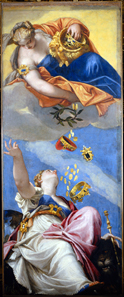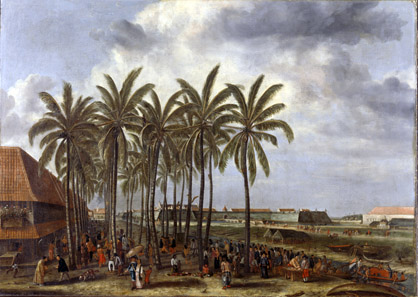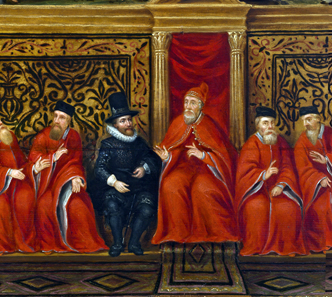September 13, 2012 – The economy is all of us, as the expression says: ‘It’s the economy, stupid!’ The Landesmuseum Zurich is holding a historical exhibition from 14 September 2012 to 17 February 2013 that will show how it all began. ‘CAPITAL. Merchants in Venice and Amsterdam’ deals with the origins of our economic system, capitalism.
Paolo Veronese, Juno Bestowing her Gifts on Venice, c.1553. Doge’s Palace, Venice. © 2012. Photo Scala, Florence.
The premise for the exhibition ‘CAPITAL. Merchants in Venice and Amsterdam’ is the notion that while we are prepared to voice our opinions on what is currently the most dominant economic system globally, we know far too little about the whys and wherefores of that system’s origins. The exhibition focuses on the emergence of capitalization and financial instruments between the late Middle Ages and the early modern age. It also looks at the merchants and traders who invented these instruments.
Hendrick Cornelisz Vroom, The Mauritius and other East Indiamen, c.1600-1630. Rijksmuseum Amsterdam.
Venice from the 13th century and Amsterdam in the 17th century both played a significant role in the economic and social development of the West. Merchants from both cities developed financing instruments for their local and long-distance trading that are still used today. Both cities faced the sea, took risks, built merchant ships and suffered losses – but also made large profits. And both cities invested their increasing wealth in art and splendour before their ‘Golden Age’ came to an end.
International loans from Italy and the Netherlands – most of which are being exhibited in Switzerland for the first time – tell the history of both cities: model ships, nautical instruments, rare sea charts, handbooks for merchants, architectural models, sumptuous gold and silver objects, magnificently illustrated folios, etc. Films produced especially for the exhibition explain why (long-distance) traders and merchants from the early modern age developed trading partnerships, credit markets, public companies, central banks, etc. When and why, for example, was double-entry bookkeeping first developed? These days state borrowing is a much debated topic, but when did it begin? What was the reason behind the bill of exchange that allowed 13th century merchants to change gold into paper currency and vice versa? Why was paper money introduced, and central banks?
The exhibition explains the development of our economy using the examples of two cities far away from Switzerland. However, the economy of our country today, with its (export) industry, its trading companies and its finance industry, was also founded on instruments developed by merchants south of the Alps and on the Atlantic. Risk and (long-distance) trading, the issuing of interest-bearing government bonds to finance public services, the creation of wealth, an orientation towards cultural representation and pleasure: these dynamics are also reflected in astonishing parallels that can be drawn between Venice and Amsterdam, on the one hand, and Switzerland on the other.
What appears to be historical turns out to be surprisingly relevant to the present day.
Tour of the exhibition
The exhibition ‘CAPITAL. Merchants in Venice and Amsterdam’ is located in the west wing of the Landesmuseum Zurich. Using models, paintings, nautical instruments, historical costumes and films, the exhibition examines the historical origins of our current economic system.
Introduction
One would not want to be in this man’s shoes, because he is screaming in fear while winged demons carry him off to Hell. The tale of the rich man who sacrificed his heart for money is the focus of a dramatic work by the painter Hans Fries, which can be seen at the beginning of the exhibition ‘CAPITAL. Merchants in Venice and Amsterdam’. The visual language of this painting, which appears on a panel of the Altarpiece of St. Anthony (1506), reminds one of modern comics. As a counterpoint to this image, a replica of the so-called Zürcher, or St. Gall Globe, is exhibited in the same room. Constructed in 1570, the globe symbolizes the self-confidence of the up-and-coming merchants, an affirmation that the world belonged to them. The exquisitely coloured replica, which was made in 2009 and is on loan from the Abbey Library of Saint Gall, is being exhibited in Zurich for the first time.
Venice: public-private partnership in the 14th century
In the next rooms, which are devoted to the maritime republic of Venice, you will encounter equally beautiful exhibits, most of which are also being displayed in Switzerland for the first time. From the 12th century to the beginning of the 16th century the Venetian merchant fleet ruled the waves, particularly in the Eastern Mediterranean.
Jacopo de’ Barbari, Portrait of the mathematician Luca Pacioli and an unkown young man, c.1500. Museo di Capodimonte, Naples. © 2012. Photo Scala, Florence – courtesy Ministero per i Beni e le Attività Culturali.
Surrounded by water and without any cultivable land in the area, the Rialto’s inhabitants had long since learnt how to live with and from the sea, and it is to the sea that the city owed its wealth and glory. As well as presenting Venetian model ships, nautical instruments, rare sea charts and handbooks for merchants, the exhibition explains a system whereby long-distance trading voyages were pre-financed at the dawn of merchant capitalism.
Vittore Carpaccio, Lion of San Marco, 1516. Doge’s Palace, Venice. © 2012. Photo Scala, Florence.
It was an innovation in 14th century Venice, an ingenious and modern system of incanto that the maritime republic devised for its long-distance trading: an early form of public-private partnership. Venetian merchant galleys were built down to the basic fittings at the state-owned Arsenal shipyards. Private merchants could buy ship shares at auction, but were then responsible for providing the galley with a crew, tools, spare parts, navigation instruments and other everyday paraphernalia.
Media room: the development of markets and financial instruments
After the Venice rooms we come to the media room, where films explain why traders and merchants in the early modern age developed markets, trading companies, credit markets, public companies, etc. – and why the introduction of double-entry bookkeeping and the bill of exchange was of the utmost importance. There is much discussion nowadays about government bonds, but when were the first such bonds issued, and what does the term ‘national debt’ mean exactly? Why did banknotes and central banks develop in the first place? The answers to these questions can be found in the media room.
Amsterdam’s Golden Age
In the following rooms the visually opulent staging of the exhibition presents the city of Amsterdam, which before it became the centre of world trade in the 17th century was just like any other city. Amsterdam realized, as did other cities, that although the ocean was a dangerous place it also provided a great deal of opportunities for good business. Amsterdam’s traders were especially resourceful when it came to the pre-financing of their long-distance trading voyages, which involved sailing on the open seas for months on end. The oldest surviving share, which dates from 1606, was discovered in the Dutch town of Enkhuizen in 2010. It can be seen at the exhibition, where it serves as a reminder that it was in the ‘city of canals’ that the idea of the public company originated.
Andries Beeckman, The Fortress of Batavia, as seen by Kali Besar Westen, c.1656. Rijksmuseum Amsterdam.
The Dutch East India Company financed trading operations with East India. Utilitarian and luxury goods testify to the speed at which Amsterdam flowered during its ‘Golden Age’ – and how a pre-modern form of the middle class developed in a liberal atmosphere where religious freedom prevailed. Essentially, Amsterdam became wealthy due to its trade with and in Asia. Browsing through magnificently illustrated folios allows us to explore the extensive trading relationships forged by Amsterdam’s long-distance traders in Asia. The richly illustrated maps and pictures tell the story of early globalization of East India.
In full bloom – and then what?
For both Venice and Amsterdam the affluence they achieved meant that luxury and pleasure became more appealing than high-risk, long-distance trade. This led to an investment in culture and art and, in turn, resulted in the waning of the Golden Age in both cities.
The future visits the past: Reception of the Dutch ambassador Cornelis van der Mijle by the doge of Venice in the year 1609. Unknown painter (probably Odoardo Fialetti, 1573-c.1638), Oil on panel. Loan: Zeeuws Archief Middelburg, The Netherlands, Collection community of Veere.
The exhibition looks at this shift towards splendour with the help of models of villas belonging to the Venetian patriciate, which set its gaze increasingly upon the mainland, the so-called terra firma, rather than the sea. The Amsterdam section of the exhibition concludes with fifty paintings from the Dutch Baroque from the Jakob Briner Foundation, Winterthur, which are hung in a style inspired by historical Kunstkabinette.
Epilogue
Finally, there is a deliberately abrupt transition to the exhibition’s ‘Epilogue’ room, in which we are suddenly confronted with contemporary Chinese art. A short panel text – similar to those found throughout the exhibition – explains this leap from history to the present day.
Parallels and connections
The exhibition explores the development of our economy using the examples of two cities far away from Switzerland. However, the Swiss economy as it is today, with its (export) industry, its trading companies, its finance industry and its government bonds or national debt, was also founded on instruments that were developed by merchants south of the Alps and on the Atlantic.
For detailed information on the supporting programme and opening hours, please visit the website of the Landesmuseum Zürich.










